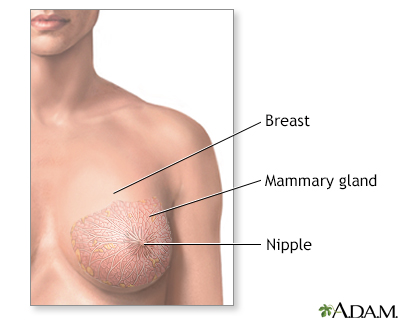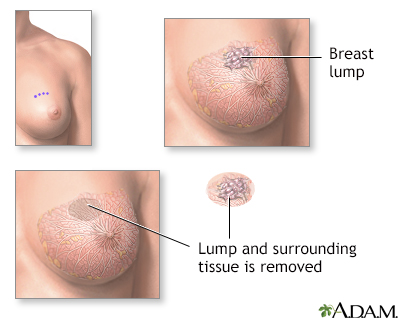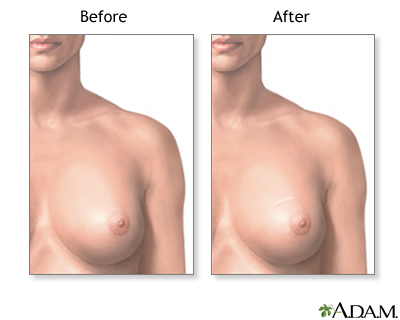Breast lump removal
| Normal anatomy |
|
The female breast is composed mainly of fatty tissue interspersed with fibrous or connective tissue. The circular region around the nipple is often a different color or pigmented. This region is called the areola.
|
|
| Indications |
|
Most breast lumps are not diagnosed by a healthcare provider, but are detected by women who give themselves breast self-examinations. Any breast lump that persists beyond a few days should be reported to a healthcare provider. Almost two-thirds of all breast lumps are benign, but the chance of a malignant lump is greatly increased if the woman is past menopause. Ultrasound and mammogram may be used to see if a lump is a cyst filled with fluid or a solid mass of tissue. If the lump is a cyst, it can be left alone or aspirated if it causes symptoms. If a cyst appears suspicious on imaging, needle aspiration or needle biopsy can be performed. If the lump is a solid mass, the next step is usually a needle biopsy performed by a radiologist or breast specialist. The tissue is checked by a pathologist to see if it is cancer or not.
|
|
| Procedure |
|
Sometimes a mass needs to be removed to see if cancer is present. This is called an excisional biopsy. While the patient is awake and pain-free (using local anesthesia) or asleep and pain-free (using general anesthesia), an incision is made over the lump. The length and position of the incision will depend on the size and location of the lump that needs to be removed. After the lump is removed in one piece, it is sent to the pathologist for a microscopic exam. The final report usually is done several days later.
|
|
| Aftercare |
|
The outcome of the excisional biopsy depends on the type of lump found. If the lump is benign, no further treatment is required. If the lump is malignant, the treatment can include surgery, radiation, chemotherapy and endocrine therapy. The choice of treatment will be discussed with you by specialists in each area.
|
|

Review Date:
2/3/2025
Reviewed By:
Warren Brenner, MD, Oncologist, Lynn Cancer Institute, Boca Raton, FL. Review provided by VeriMed Healthcare Network. Also reviewed by David C. Dugdale, MD, Medical Director, Brenda Conaway, Editorial Director, and the A.D.A.M. Editorial team.
The information provided herein should not be used during any medical emergency or for the diagnosis or treatment of any medical condition. A licensed medical professional should be consulted for diagnosis and treatment of any and all medical conditions. Links to other sites are provided for information only -- they do not constitute endorsements of those other sites. No warranty of any kind, either expressed or implied, is made as to the accuracy, reliability, timeliness, or correctness of any translations made by a third-party service of the information provided herein into any other language. © 1997-
A.D.A.M., a business unit of Ebix, Inc. Any duplication or distribution of the information contained herein is strictly prohibited.
© 1997-

All rights reserved.





